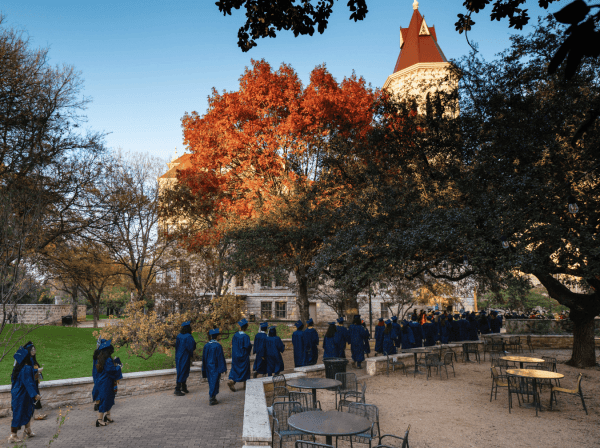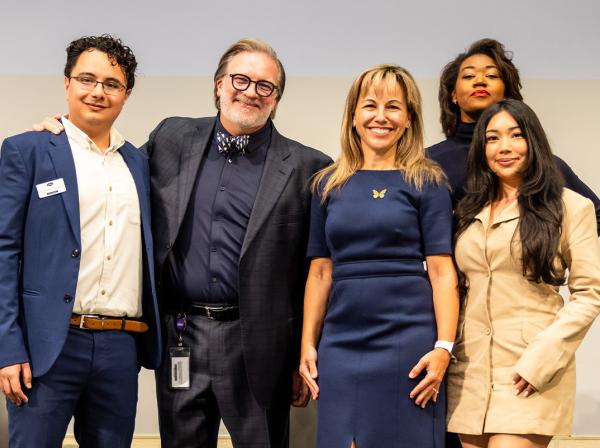Setting Her Sights
Chelsea Elliott ’12 has been blind in one eye and deaf in one ear since childhood. Now, she is helping revolutionize the vision screening process that could have prevented her own impairment through her nonprofit, the Half-Helen Foundation.
A 7-year-old named Hector stands on the purple stripe of the rainbow rug in his second-grade classroom in Austin. He grins, two teeth missing, as Chelsea Elliott ’12 tells him she’s about to take his picture. She clicks a button, and he looks into the camera’s laser-like swirl of red, green and blue lights. “Cool!” he says. “It’s like a video game!” In two seconds, it’s done, and Hector is back in circle time listening to his teacher read a chapter from one of the Magic Tree House books.
But in those two seconds, Elliott has captured a detailed picture of Hector’s eyes and screened him for signs of five of the most common eye disorders, including near- and farsightedness, astigmatism, pupil size difference, and strabismus. The data come from a special technology called a Spot Vision Screener, which looks like a hybrid of an iPad and a Polaroid.
The Spot camera snaps one shot of both eyes simultaneously, and 97 percent of the time, one shot is all it takes to get the critical information. Elliott can be up to 3
feet away and still get an accurate reading. Decreased time and increased distance are essential benefits for screening kids, who wiggle, wander, get distracted easily and often have stranger anxiety. Even more important, the camera can take readings in children as young as six months — well before they can articulate a physical problem and before they can identify letters on a traditional eye chart.
In Hector’s case, the camera identifies astigmatism and nearsightedness, easily correctable conditions he has likely had for years but wasn’t bothered by because of adaptations made by his young brain. Over the next two weeks, Elliott will send a letter home to Hector’s parents explaining what the Spot camera found. A mobile vision clinic will come to his elementary school, where a pediatric optometrist will give him a complete eye exam and fit him for his first pair of glasses. All for free.
The high-tech screenings and follow-up eye care are provided by the Half-Helen Foundation, the nonprofit Elliott founded when she graduated from St. Edward’s University.
Darkness and Light
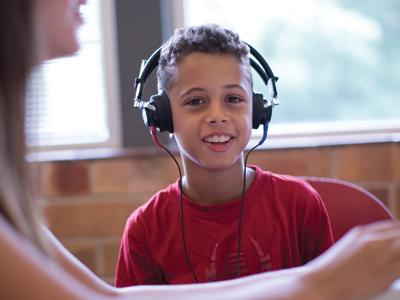
Even after 21 years, Teresa Elliott still remembers getting the call from the preschool. Texas had just passed a law requiring vision screenings for 4-year-olds, and Chelsea had failed hers. “The woman who did the exam told me something was wrong with Chelsea’s eyes. ‘I’m not a nurse,’ she said, ‘but I’ve been doing this a long time, and I’ve never seen eyes like your child’s. She needs to see a doctor.’”
Teresa got an appointment the next day with an optometrist who was a family friend. Within five minutes of starting the exam, he asked Chelsea if she wanted to play with the blocks in his waiting room. Then he delivered the news to Teresa: Her 4-year-old daughter was completely blind in her left eye. A bevy of tests later they were able to rule out cancer, but not much else.
After consultations with six doctors, they finally got a diagnosis: Coats’ disease, which causes the blood vessels in the back of the eye to leak. In the early stages, the leaked fluid leads to blurred vision and floaters. As the disease advances, the retina eventually detaches and causes permanent blindness. Chelsea’s eye, the specialist explained, was in the very latest stages and too late to reverse. It would eventually atrophy and need to be removed.
Just as they came to terms with that news, Chelsea started kindergarten and failed a routine hearing test. More doctors, more tests, and she learned she was deaf in her right ear. Unrelated to the Coats’ disease that had taken her eye, her hearing loss was attributed to three tiny but crucial bones missing in her inner ear, most likely destroyed by infections when she was a baby.
“We could have shut down. It was devastating, on top of everything else we’d been dealing with,” says Teresa. “But I remember holding her and thinking that, somehow, something good had to come from this.”
They coped. They adapted. They learned as they went. Chelsea figured out where she needed to sit at school to be able to hear the teacher and see the chalkboard. She learned to play volleyball and basketball with just a 90-degree field of vision. And her body slowly began to compensate for the lack of depth perception that unilateral blindness causes.
In fourth grade, she did a research project on Helen Keller — and coined a nickname for herself. “Helen Keller was completely blind and deaf,” she told Teresa, “and I’m half that. I’m Half Helen!” The name stuck.
Lost and Found
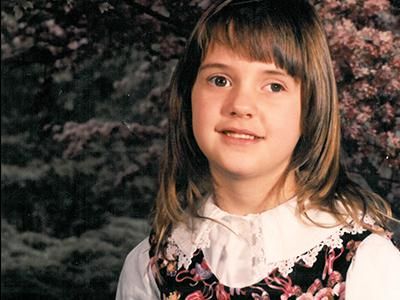
The summer before her sophomore year in high school, Elliott and her family decided to have her eye removed. The tissue had atrophied, a cataract had developed on her lens, and her blind eye was visibly smaller than her other eye. After the surgery, she wore an eye patch for six weeks and then spent two weeks getting fitted with a prosthetic. The physical recovery was “a piece of cake,” she says, “compared to the emotional one.”
She started having nightmares. She withdrew from her friends and from the sports and clubs she had once loved. “To everyone else, I was still the long-legged, curly haired, 15-year-old girl known for my wild spirit and infectious enthusiasm,” she says. “But it felt as if the doctors had removed that part of me, along with my eye, during the surgery.”
Teresa remembers the first time Chelsea looked in the mirror after leaving the hospital recovery room. “She asked me, ‘Mom, what have I done?’ and she just lost herself,” says Teresa. “I sat there and watched my vivacious 15-year-old lose her identity.”
But Teresa, the founder of the NYOS Charter School that Chelsea attended, also challenged her daughter. “As a parent, it was a humbling experience. You just try to protect your child as best you can,” she says. “But as an educator, I was hard-wired to push her into finding her purpose, into living a life without fear and regret.”
Teresa had some help along the way. Chelsea’s AP World History teacher, Matt Abbott ’03, introduced her to St. Edward’s, where she enrolled in the fall of 2009. During the spring semester of her sophomore year, she decided to study abroad with Associate Professor of Communication Lori Peterson. “Going to Angers, France, was the first major risk I had taken since getting my eye removed,” Chelsea says. “I really think that experience saved my life. I had spent years avoiding anything that might be painful or hard — but also things that might bring me joy. In Angers, I finally began to let myself feel happy again.”
And when she got back to campus, it was time to face —and tell — her own story. In a class with Associate Professor of Communication Stephanie Martinez, she had to craft an autoethnography, a type of self-reflection that connects to wider social, political and cultural themes.
“Part of autoethnography is finding your story and figuring out your way. Chelsea had been carrying all of that around inside, and she was finally ready to articulate and share it,” Martinez says. “At the time, we both thought the next step would be for her to publish her story so that other people could draw strength from it. Yes, she had this terrible thing happen to her, but she was beginning to see it as a positive, as a reason to move forward instead of an excuse not to.”
Spot On
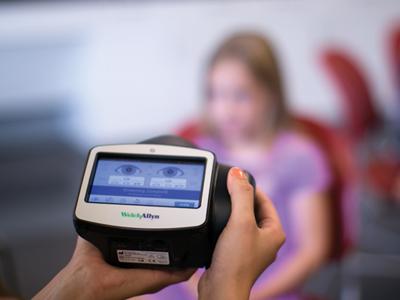
Chelsea had known about the Spot camera since the year after she got her prosthetic eye. A family friend and member of the West Austin Lions Club (an organization her parents had been involved with since before her diagnosis with Coats’ disease) told her about the technology at a club meeting.
Around the same time, the American Academy of Pediatrics began recommending vision screenings in children as young as age3. Had the camera and the recommendations been in place during Chelsea’s childhood, she realized, her doctors could have caught the Coats’ disease in its earlier stages — and likely saved her sight.
“That didn’t happen, obviously,” she says, “and it really got me thinking. I don’t remember what it’s like to see with both of my eyes and hear with both of my ears, but other kids don’t have to go through what my family and I did. We have the technology now to identify potentially serious problems like Coats’ disease. So why don’t we use it?”
When she completed her bachelor’s in Communication at St. Edward’s, she took the money she’d gotten as graduation gifts and filed the paperwork for a nonprofit that would provide free vision and hearing screenings to children in need. She called it the Half-Helen Foundation.
Chelsea then presented the idea to the West Austin Lions Club, which agreed to purchase the $8,000 Spot camera for Half-Helen. She also talked with Abbott, her old high-school teacher, about using an office at Wayside Schools, which he directs, in exchange for free screenings for its students. And with general donations, she purchased two audiometers to conduct traditional hearing screenings when schools needed them.
“That purpose I had been waiting for her to find for 20 years,” says Teresa, “was finally happening!”
Aloha, Hawaii
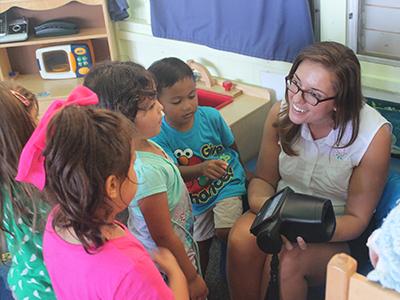
With the technology, the space and the students all lined up, Elliott hit a roadblock. The state of Texas had not yet approved the Spot camera for use in school screenings. While she waited for the bureaucratic red tape to get cut through, Elliott began researching other communities with children in need of screenings. She landed in Hawaii.
Hawaii had discontinued mandatory school vision and hearing tests in 1995 because of budget shortages. The state also ranked below the national average on most Department of Education assessment metrics, statistics that can sometimes reflect students’ inability to see or hear test instructions and questions. Elliott began emailing Lions Clubs and schools on the state’s eight main islands about the possibility of Half-Helen conducting screenings there.
She contacted the Maui Lions Club and one local school and flew out to make a pitch. A week later, she was back in Austin writing a business plan to screen every student in each of the public schools on Maui and neighboring Lanai. The result was Maui 528, named for the number of hours it would take to screen each of the 21,119 students in Maui schools at 90 seconds each — the time it takes to carry out a comprehensive vision and hearing assessment with the Spot camera and audiometer.
Maui 528 began in June 2013. Later that year, Elliott began commuting between Maui and Austin to conduct screenings at several Austin charter schools. In the two years since, she has screened nearly 10,000 children in the two states. When the Maui 528 project went more slowly than she anticipated because parents had to opt in for their children to participate, Elliott began talks with the county about changing to an opt-out system. She also joined a state task force to lobby the departments of Health and Education to reestablish mandatory in-school screenings in Hawaii.
And with the Austin-area program growing to include three more charter schools, Elliott has partnered with Kids Vision for Life Central Texas, the mobile vision clinic that treats students with problems identified by the Spot camera, like 7-year-old Hector.
A Hero's Journey
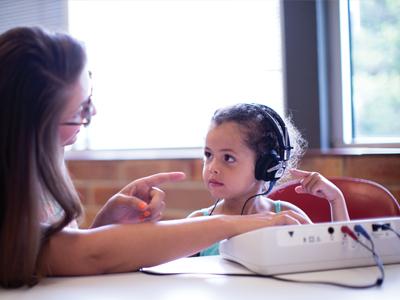
These days, Elliott divides her time between Austin and Kahului on Maui. She screens the students at Wayside Schools during the fall, travels to Hawaii in the winter and spring, and returns to Austin in the summer to fundraise and develop partnerships with other local schools and nonprofits. She has also hired a full-time data analyst and acquired a second Spot camera through an Atherton Family Foundation grant.
Though she’s used to being behind the camera, she’s getting a lot of attention in front of it. Earlier this year, she was nominated for the national CNN Heroes program by the West Austin Lions Club and selected as one of 25 individuals to be honored. Later this year, 10 of those heroes will be selected as finalists by the network. One winner will be chosen through online voting and will receive $100,000.
Although the spotlight is nice, her sights are “absolutely” set on expansion. Besides Hawaii, seven states still do not require vision screenings (and no state completes them with Spot camera technology). Internationally, Elliott is likely to find a built-in support system and network of volunteers at any of the 46,000 Lions Club chapters across the globe — the organization has long advocated for vision care in poor communities and has been one of Half-Helen’s biggest supporters in Maui and Central Texas.
Living with partial blindness and deafness has, ironically, given her perspective. “Vision screenings aren’t sexy or edgy,” says Elliott. “People think, ‘Oh, you can’t see? Well, get a pair of glasses.’ But it’s much more than that. We can prevent so many things, and what we can’t prevent, we can catch early and treat. It’s high-impact and
low-cost.”
For Teresa, the organization has brought Chelsea full circle. “Everything she’s been through has motivated her and given her the strength to get on a plane, go to a strange place, and talk to people she doesn’t know day in and day out,” says Teresa. “My strong, creative girl who was always the center of attention when she was 4 has finally fought her way back.”
Photography by Morgan Printy
